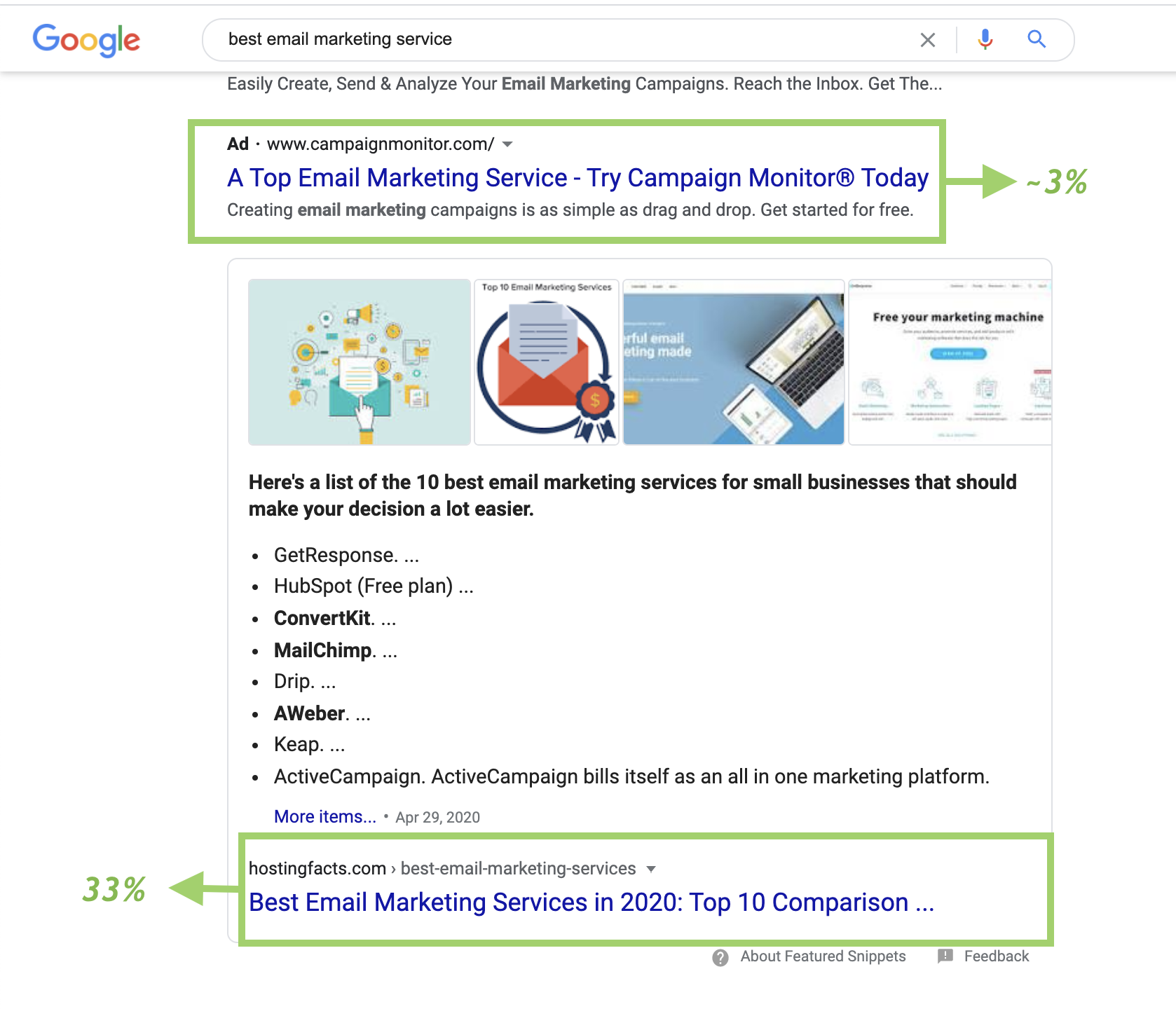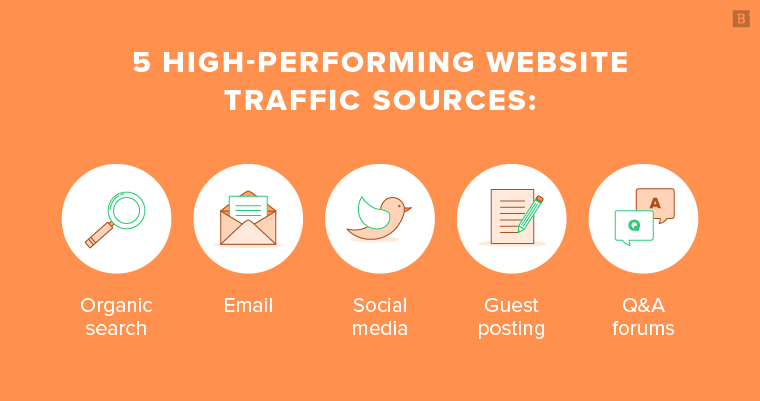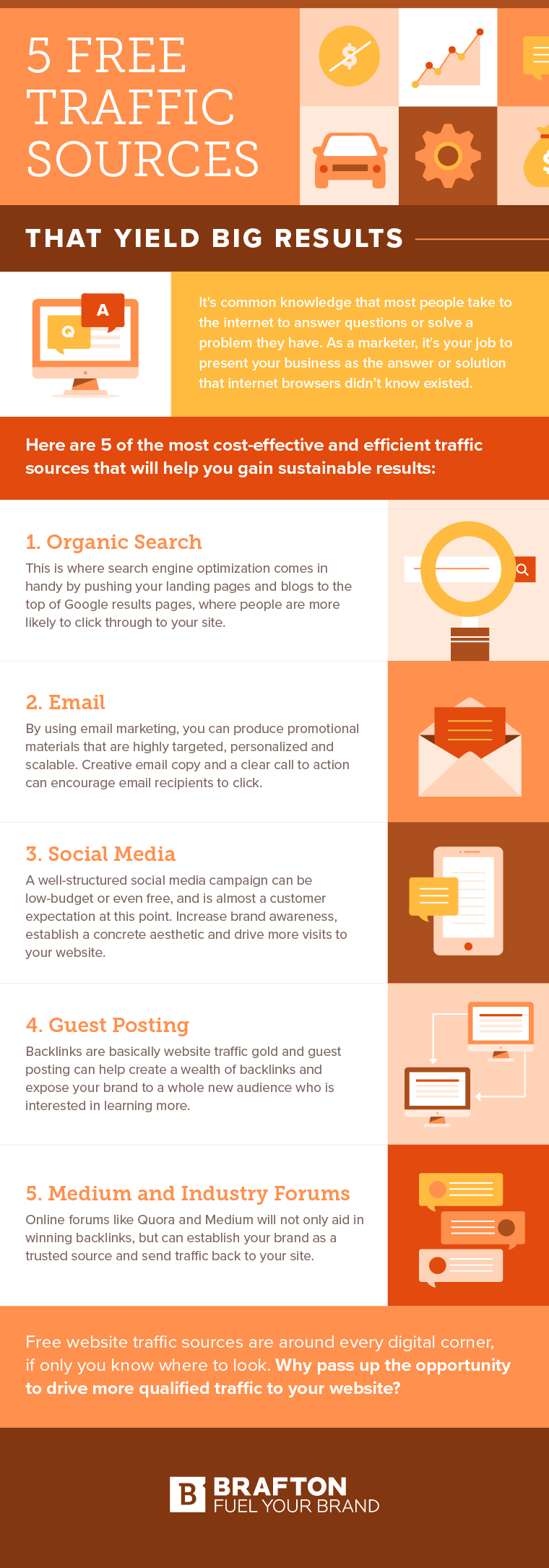Think about some of the websites you might visit in a day.
How many do you think you arrived at by clicking on ads? Probably not many.
Most people search the web to find a solution to a problem or dig up information that will help them get something done. Ads are usually interruptions to those goals.
Data from Advanced Web Rankings supports this.
The average click-through rate of an ad on Google search is around 3%.
By comparison, the first organic search result will get clicked about 33% of the time. That gradually decreases as you go down the page:
- Position 2: 16% CTR.
- Position 3: 10% CTR.
- Position 4: 7% CTR.
- Position 5: 5% CTR.
- Position 6: 3.5% CTR.

So, even though a paid search result sits at the very top of Google, users will click on it about as often as they might click on a listing in the seventh or eighth organic search position.
For display ads and banner ads that appear on webpages, the CTR is even lower: about 0.5%.
Ads and ad networks have a place in a marketing campaign, to be fair. But when it comes to generating traffic, paid doesn’t hold a candle to free.
If you’re trying to boost inbound leads, your best bet is to focus your energy on the 5 free traffic sources that will yield sustained results at scale:
Let’s look at how to use – and measure success – on each of these high-performing website traffic sources:

1. Organic Search
More than 50% of all website traffic is generated through search engines.
When people want answers, they ask Google. Therefore, figuring out what people are searching for and how to rank for those queries has the greatest potential value in terms of generating traffic.
It won’t cost you a cent in ad spend.
But it will cost you in time and effort.
How To Use It
Search engine optimization (SEO) is the name of the game. We’ve written entire eBooks about SEO, and there is a lot that goes into the practice.
However, here’s the high-level checklist for improving website traffic from organic search:
- Make sure your site is properly set up to be indexed in search results.
- Figure out your most valuable commercial-intent keywords (aka, the ones your target audience uses when shopping for products or services like yours) and make sure your commercial landing pages are optimized to rank for those keywords.
- Re-optimize blog posts and landing pages that are within striking distance of Page 1 for specific keywords; this is one of the most immediate, cost-effective ways to improve search traffic.
- Use keyword research tools to identify additional short- and long-tail keywords that you want your site to rank for; start creating blog posts that are optimized to rank for those keywords. We recommend targeting 1 keyword per blog post.
- Earn backlinks to your site by guest blogging or by reaching out to other content publishers incentivizing them to link to your site (for instance, by linking to their site, or by offering them a free license to your software).
- Conduct technical SEO audits (e.g., for mobile friendliness, broken links, site structure, Schema markup, etc.).
We covered a lot of this, and more, in an earlier blog post. Read it here to learn more about organic SEO.
Subscribe to
The Content Marketer
Get weekly insights, advice and opinions about all things digital marketing.
Thanks for subscribing! Keep an eye out for a Welcome email from us shortly. If you don’t see it come through, check your spam folder and mark the email as “not spam.”
How To Track Success on Organic Search
Google Analytics
Google Analytics is crucial not just for SEO, but for any and all digital marketing campaigns that are tied to your website. It’s a rabbit hole of information about your site. At a bird’s-eye view, some of the most important metrics to pay attention to as you track your traffic include:
- Sessions: Begins when a user arrives at any page on your site and ends when they leave.
- Users: Users will tell you exactly how many unique individuals have come to your site.
- Channels: This will tell you the traffic sources bringing in users (organic, direct traffic, paid traffic sources, social media, email, etc.).
- Audience: You can find clues about your audience, including their interests, demographics, location, preferred devices, etc.
- Conversions: You can set up conversion goals in Google Analytics and track them.
- Engagement metrics: Also look at bounce rate, pages per session, session duration, and other behavioral metrics to try to understand how your inbound traffic engages with your site content.
As a general rule, always keep an eye on year-over-year progress. This is important for understanding variables – for instance, recognizing that a traffic drop in Q4 is just the result of the holiday season. Google Analytics makes it relatively easy to conduct comparisons of YoY traffic, and see how specific SEO efforts and other variables affect traffic to your site.

Google Search Console
Search Console is even more directly tied to organic search than Google Analytics. It shows you the indexing status of your webpages while elaborating on the performance of those pages in search.
Some of the key metrics to pay attention to on Search Console include:
- Impressions: The number of times one of your pages displays in search engine results.
- Clicks: The number of times someone clicks on one of your pages listed in search results.
- Click-through rate: The percent of impressions that resulted in a click.
- Average position: Average position of your site and its pages in search results.
You can also look at the specific queries that your site is ranking for to see exactly which ones are generating the most impressions and clicks.
Unlike Google Analytics, your ability to do year-over-year comparisons is limited. Google Search Console only shows you data from as far back as 16 months. However it can still be useful to compare timeframes (e.g., the last 45-day period against the prior 45-day period). Also keep in mind that “traffic” technically isn’t a Search Console metric. That said, “clicks” will tell you how often users are selecting your webpages from search results, and that’s a key indicator of search-based traffic.

2. Email Marketing
On average, each dollar spent on email marketing generates a return of $44. This return on investment is so high for a few reasons. Namely, email marketing is:
- Highly targeted.
- Personalized.
- More direct (the messages go straight to an inbox).
- Relatively easy to scale.
How To Use It
Technically, email marketing isn’t free, as one of the first things you’ll need is a subscription to an email automation platform such as Marketo, Mailchimp or Pardot. (Strictly speaking, all marketing costs money; but email and the other channels on this list are not paid traffic sources – you’re paying for the time, energy and tools that help you generate organic traffic, not the actual traffic.)
Email automation makes it much easier to segment your email database into manageable lists based on contacts’ attributes such as location, job title, etc. It also helps you create, schedule and send emails to your lists.
As for the “how” of email marketing, there are a few steps involved if you’re trying to do it at scale. Let’s review the main ones:
- Build your email database. You can do this by paying for pre-built email databases, but we recommend building your own database by capturing emails addresses organically – for instance, featuring a “subscribe” button on your website or blog, or setting up a scroll-activated pop-up box. Just remember that you need to have some incentive to get them to sign up (great content, discounts, etc.).
- Segment your audience. Focus on attributes that are most important to your brand. That could be location, job title, age, gender, customer vs. potential customer or some combination thereof.
- Create an email newsletter. We’re huge fans of the newsletter. It’s a non-salesy way to share useful content and information with subscribers. It’s also a great way to support your organic SEO efforts, specifically by distributing and promoting your content for SEO, and driving traffic to those pages.
- Maintain your email database. Over time, some of your contacts will leave their current company, or perhaps change their email address. To maximize deliverability and avoid sending emails to inactive addresses, make sure you’re maintaining your database on a regular basis.
- Launch other email marketing campaigns. Drip campaigns, lead-nurture emails, onboarding emails – all of them have a place in your email marketing strategy. In addition to driving traffic to your site, they can help move leads deeper into the sales funnel.
To learn more about the steps involved in email marketing and how to create great email content, check out this post.
How To Track Success of Email Marketing
Outside of the obvious wins – people responding to set up a meeting with sales – you must methodically monitor your incremental gains. At a minimum:
- Create custom URLs to track traffic generated from email in Google Analytics. You can do that using Google’s free Campaign URL Builder.
- Pay attention to metrics such as deliverability, open rate, click-to-open rate, click-through-rate and conversion rate. These should all be trackable through your email marketing automation platform.
If you’re chiefly concerned with traffic to your site, then it’s crucial that you create the aforementioned custom URLs.
Otherwise, keep an eye on your email engagement metrics, as these will help you figure out the types of subject lines and content that recipients are most likely to open and engage with.
3. Social Media
When it comes to website traffic sources, the likes of Facebook, Twitter, LinkedIn and other social media channels can’t contend with organic search. Since 2014, social has driven about 5% of web traffic each year, compared to 53% from organic search.
This is likely because most engagements on social media happen without ever leaving the platform. Users often scroll through their feed, glancing at comments, images, watching videos on mute and occasionally liking something they see or leaving comments.
Nevertheless, a social media presence is more or less an expectation – both in B2B and B2C companies. Even more importantly, social can and often does have very real brand-awareness, lead-generation and traffic-boosting benefits for your website.
How To Use It
Brand awareness is the No. 1 reason that most companies (69%) use social media. The second biggest reason is increasing traffic (52%).
Technically, the two aren’t mutually exclusive. If your social media followers are more engaged with your brand, they’re that much more likely to click on a link that navigates to your website.
With that in mind, let’s look at the main steps involved in driving free targeted traffic through social media:
- Create content worth sharing: Before you have a prayer at expanding your audience, you need content worth sharing with them. Create blog posts, illustrations and videos that will interest potential followers, and start posting them to your social media channels.
- Promote your social pages on your site: Make sure you have clear links to your social media pages on your website. This will help funnel some traffic to your social media pages. That may sound counter-intuitive, but if you get a casual site visitor following you on social media, you essentially create a consistent line of communication with that person – ergo, they become a lead.
- Collaborate with influencers: By “influencers,” we don’t mean Kylie Jenner. We mean the unpaid kind – industry peers, thought leaders and even satisfied customers. Reach out to them through social messaging tools, requesting that they follow you in exchange for mentions on your site or social media channels. Engage with the content they post to help be seen by their audiences. Social behavior begets success on social media.
- Promote your blog posts on your accounts: Just as you would distribute your content on email, do the same on social media. This will ensure that members of your audience who may not have subscribed to your newsletter but follow you on social media see your content updates.
How To Track Success of Social Media Marketing
Each social media channel is a little different and therefore may have KPI nuances. But across all channels, there are a few common metrics to pay attention to:
- Sessions on Google Analytics: Google Analytics will tell you exactly how much of your site traffic is arriving through social media channels.
- Impressions: Tells you how many times one of your posts shows up in a user’s feed.
- Reach: Tells you how many users have seen one of your posts.
- Click-through rate: Percent of impressions that led to clicks.
- Engagements: Comments, likes, clicks, re-Tweets, shares, etc.
- Cost per lead: The amount of money you spent managing organic social (usually as a function of time and effort) against the number of leads you earn.
With the exception of “sessions on Google Analytics,” you can monitor the above metrics through each channel you post on or through a social posting platform like Sprout Social.
To learn more about social media marketing KPIs, check out our post on the subject here.
4. Guest Posting
Backlinks are highly valuable from an SEO perspective. And as we already established, SEO is crucial to driving organic search traffic.
One of the ways to earn high-quality backlinks to your site is to submit guest blog posts to websites with a strong Domain Authority. If that site publishes your guest post, Google will interpret any links back to your site as a vote of confidence.
Not to mention, you potentially expose your brand to another publisher’s audience.
How To Use It
In a nutshell, seek out respectable industry news sources and blogs and try to get in touch about becoming a contributor. Our CMO, for instance, is a regular guest contributor to Moz. Having his content on their site helps earn us backlinks, but it also gets our brand in front of Moz’s audience.
And unlike affiliate marketing – which often involves paying a commission to the publisher who links back to your site – guest posting is a mutually beneficial, non-monetary exchange. In exchange for brand exposure on someone else’s blog, you give them great content that will support their own content marketing goals.
How To Measure Success
This one’s easy: Review your referral traffic in Google Analytics.

Google Analytics will also show you exactly where those referrals are coming from. Keep this in mind as you think of sites you might want to reach out to about guest posting. If they’re already referring to your domain – and their site has a strong Domain Authority – then by all means, follow that thread.
5. Medium and Industry Forums
There’s more than one way to win backlinks and referral traffic.
Enter Medium, Quora and other online forums.
How To Use Them
Let’s start with Medium.
If you create a piece of content on Medium – preferably one that’s optimized for a specific keyword (because you want that content to perform well in organic search, right?) – you can link back to your own domain within the body of the content or in your bio. That backlink can act as a source of traffic to your site.
Then there’s the Reddits, Quoras, Stack Overflows and countless other online forums that people go to with questions they can’t readily answer or find on the web.
Quora, for instance, has especially strong search visibility. If you can anticipate your audience’s questions, find them on Quora, and provide a link to your website that answers the question, you can help drive traffic to your domain.
The same goes for Reddit and other forums.
How To Measure Success
Again, all you really need to do is track your referral traffic in Google Analytics.
You can see exactly what percentage of your site traffic is generated by referrals from other sites, and see what those sites are.
Conclusion: Prioritize Free Traffic Over Paid Traffic
If there’s only one thing you take away from this post, let it be this: Free website traffic is almost always more abundant than paid traffic.
If you have any doubts about this claim, just look at your own Google Analytics dashboard. Most of your site traffic is probably through unpaid sources like organic search, email, referral maybe with some “direct,” “other” and “social media” peppered in there.
Are we wrong? Let us know in the comments.
Otherwise, continue to monitor your traffic sources and keep using your organic marketing channels in such a way that they complement one another.
More importantly, stay well, healthy and woke.



